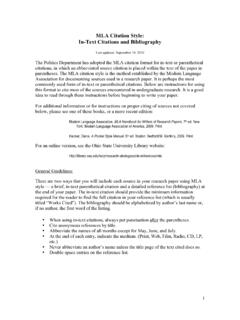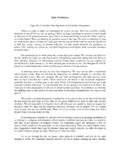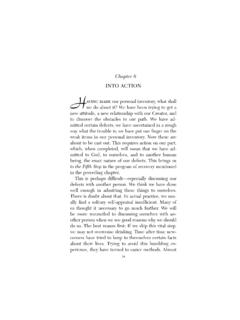Transcription of Chicago Citation Style: Footnotes and Bibliography
1 Chicago Citation Style: Footnotes and Bibliography Last updated: September 10, 2010. The Politics Department has adopted the Chicago Citation format for Footnotes in academic papers. The Chicago Citation style is the method established by the University of Chicago Press for documenting sources used in a research paper and is probably the most commonly used footnote format. Below are instructions for using Footnotes to cite most of the sources encountered in undergraduate research. It is a good idea to read through these instructions before beginning to write your paper. Please note that Footnotes are so-named because they appear at the bottom of the page that contains the text you are annotating.
2 Endnotes follow the same Citation style, but are listed together at the end of the paper before the Bibliography . Only use endnotes at the specific request of the instructor; use Footnotes otherwise. For additional information or for instructions on proper citing of sources not covered below, please see one of these books, or a more recent edition: University of Chicago Press. The Chicago Manual of Style. 15th ed. Chicago : Univ. of Chicago Press, 2003. Hacker, Diana. A Pocket Style Manual. 5th ed. Boston: Bedford/St. Martin's, 2009. Or, for an online version: Or this document on the Ohio State University library website: General Guidelines: Your Footnotes should be numbered consecutively throughout the paper.
3 Use your word processing program to insert Footnotes and it will number them for you automatically. The footnote number should always be inserted after the The first time you cite a source, you will include a full Citation . For all subsequent references to that text, your footnote Citation will be in abbreviated form. (More detail below.). Cite authors' names as they appear in the texts. Don't replace first names with initials unless the names appear this way on the title page of the source. If no author is listed, organize the entry by the title. 1. Like that. 1. Books: Single Author Footnote Basic format: x. Author's first name Last name, Title in Italics and in Headline Style (City of Publication: Publisher, Year), page number if relevant.
4 Subsequent references to the same text: x. Last name, Title in Shortened Form, page number. Note: If your second reference to a text comes immediately after the first, use Ibid. in place of the author's name and the book title. Include the page number if it is different from that listed in the first reference. Examples: 1. Kent Portney, Taking Sustainable Cities Seriously (Cambridge: MIT Press, 2003). 2. Ibid., 162. 3. David Harvey, The Condition of Postmodernity: An Enquiry Into the Origins of Cultural Change (New York: Blackwell, 1989), 197. 4. Robert O. Self, American Babylon: Race and the Struggle for Postwar Oakland (Princeton: Princeton Univ.)
5 Press, 2003). 5. Harvey, The Condition of Postmodernity, 86-87. Note: The second, third and fifth Footnotes above cite direct quotes or material found on one or more specific pages , therefore the page numbers of the source are included. Bibliography Basic format: Author's last name, First name. Title. City: Publisher, Year. Examples: References Harvey, David. The Condition of Postmodernity: An Enquiry Into the Origins of Cultural Change. New York: Blackwell, 1989. Portney, Kent. Taking Sustainable Cities Seriously. Cambridge, MIT Press, 2003. Self, Robert O. American Babylon: Race and the Struggle for Postwar Oakland. Princeton: Princeton Univ.
6 Press, 2003. 2. Books: Multiple Authors Footnote For two or three authors, list each of the authors in the order presented on the title page of the book . For more than three authors, list the first author's name followed by and others or et al. : x. First name Last name and First name Last Name, Title (City: Publisher, Date), page number if relevant. x. First name Last name et al., Title (City: Publisher, Date), page number if relevant. Subsequent references to the same text: x. Last name and Last name, Title, page number. x. Last name et al., Title, page number. Examples: 1. Harriet Bulkeley and Michele M. Betsill, Cities and Climate Change: Urban Sustainability and Global Environmental Governance (London: Routledge, 2003), 25.
7 2. Randall Arendt et al., Growing Greener: Putting Conservation into Local Plans and Ordinances (Washington, DC: Island Press, 1999). 3. Bulkeley and Betsill, Cities and Climate Change, 27. 4. Arendt et al., Growing Greener. Bibliography Basic format: Last name, First name, and First name Last name. Title. City: Publisher, Year. Examples: References Arendt, Randall, Holly Harper, Stephen Kuter, and Diane Rosencrance. Growing Greener: Putting Conservation into Local Plans and Ordinances. Washington, DC: Island Press, 1999. Bulkeley, Harriet, and Michele M. Betsill. Cities and Climate Change: Urban Sustainability and Global Environmental Governance.
8 London: Routledge, 2003. Note: In contrast to Footnotes , bibliographic citations for works with four or more authors should include the names of all authors. See the Arendt entry above. Books: Edited Volume or Chapter Within an Edited Volume Footnote Occasionally you will need to cite an edited book containing chapters by various authors. If citing the overarching idea of the entire book , use the editors' names as you would the names of authors, following their names with ed. (short for 3. editor, not to be mistaken for the abbreviation of edition ). Works with a translator (trans.) or a compiler (comp.) would be treated similarly. Basic format: x.
9 Editor's First name Last name, ed., Title (City: Publisher, Year), page number if relevant. Example: 1. Warren Magnusson and Karena Shaw, eds., A Political Space: Reading the Global Through Clayoquot Sound (Minneapolis: Univ. of Minnesota Press, 2003). Subsequent references to the same text: 2. Magnusson and Shaw, eds. A Political Space. More frequently, you will cite a particular essay or chapter in an edited book . In this case your footnote will refer to the specific chapter or essay but will also include the title of the book and its editors. The format is as follows: x. Author's First name Last name, Chapter Title, in book Title, ed.
10 Editor's name (City: Publisher, Year), page number if relevant. Subsequent references to the same text: x. Last name, Chapter Title, page number. Examples: 3. Timothy W. Luke, On the Political Economy of Clayoquot Sound, in A Political Space: Reading the Global Through Clayoquot Sound, ed. Warren Magnusson and Karena Shaw (Minneapolis: Univ. of Minnesota Press, 2003), 99. 4. Luke, On the Political Economy of Clayoquot Sound, 101. Bibliography Basic format: Editor's Last name, First name, ed. Title. City: Publisher, Year. Or: Author's Last name, First name. Chapter Title. In book Title, edited by Editor's Name, page numbers of chapter.





